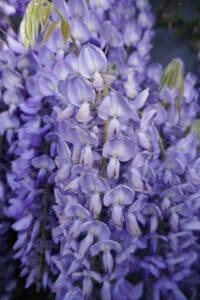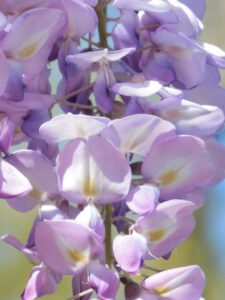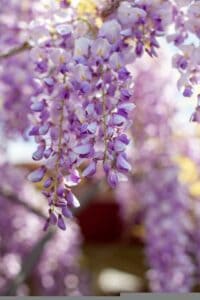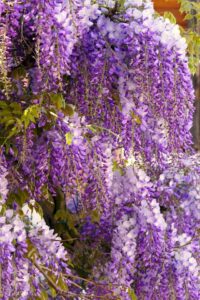Some links in the post are affiliate links and I get a commission from purchases made through some links found in the post.
The wisteria is a very hardy plant that barely needs your attention. As long as it’s in full sun, has access to water, and is in rich soil, the plant does well.
You can even go years without ever having to feed it as it has an extensive root system. Thus, it can fend for itself for the most part.
Even so, the wisteria is a flowering plant and the longer it goes without nutrients, the fewer leaves it develops.
An underfed plant will focus on growing more leaves to sustain its vining rather than focus on blooming. So, it’s always good to add some fertilizer to help the wisteria grow longer and produce healthy blooms.
The best way to fertilize you wisteria is to do a soil test and then provide it with a NPK fertilizer for the deficient nutrients.
You should also not feed you wisteria in the winter as it is in it’s dormancy phase.
But how much fertilizer can you give your wisteria? You may have heard that nitrogen-rich fertilizer is not suitable for blooming plants as it encourages foliage production rather than flower production.
So, what kind of fertilizer should you give your plant? And can you use organic options? These are all questions I will cover as I get into how and when to feed your plant:
When Should I Fertilize My Wisteria?
All gardeners often grapple with this question because timing makes all the difference. If you feed your plant at the wrong time, the fertilizer can go to waste and burn its roots.
Or you can encourage the plant to produce leaves rather than the long-awaited flowers. So, when can you feed your plant?
a) When It Is Young
 Wisterias take quite a lot of time to mature and get to a stage where they can start blooming – this is called the juvenile stage.
Wisterias take quite a lot of time to mature and get to a stage where they can start blooming – this is called the juvenile stage.
And in this phase, the plant spends its energy growing more leaves and stems. Wisterias grown from seed can spend more than 5 years in this stage, while the grafted cuttings take about two to three years.
You will notice that most gardeners take advantage of this period to train their plants to cover more ground or climb structures.
They do this so that the flowers can have a cascading effect when the plant finally starts blooming.
You can imagine that most people would want their wisterias to sprawl through the gardens and surrounding areas in readiness for this effect.
And in this case, using a fertilizer would be a great way to achieve this length faster.
b) When It Is Not Flowering Much or At All
One of the key selling points of the wisteria is its blooming capability. So, if the plant cannot bloom and yet has adequate access to sunshine and water, underfeeding is the likely issue.
In this case, you would need to rely on fertilizer to prompt the wisteria to produce blooms. Please note that when doing so, you should avoid any fertilizer that is rich in nitrogen as this would have the opposite effect.
Moreover, you should not locate the wisteria near plants that use nitrogen-rich fertilizers. The nutrients would eventually find their way to your wisteria and promote foliage production instead of blooming.
c) When It’s Constrained to a Pot
All plants grown in pots have one major disadvantage: once they use up what’s in the pot, they do not have access to other nutrients.
And as much as your wisteria can fix nitrogen from the air, it will not have access to phosphorus and potassium, which are just as important. So, you will need to step in and get a feed for your wisteria.
d) When It Shows Signs of Nutrient Deficiency
Wisterias often do well even in soils that have low nutritional value. But sometimes, the nutritional content is so low that they cannot grow well enough to support foliage and flower production.
And that’s when the following signs start creeping up:
- The plant begins developing smaller leaves compared to the ones it produced in the past: That’s a sign that the plant no longer has access to adequate nutrients and is making up for this by spending less energy on leaf production,
- The leaves on the wisteria start taking on a yellow color: If this change happens to leaves that should otherwise be healthy, e.g., at the helm of spring, you have a reason to be concerned,
- The wisteria suffers stunted growth and spreads at a much slower rate than in the past, and
- The leaves start falling off the wisteria prematurely.
All these signs can point to another issue with your wisteria, e.g., overwatering. So, the best way to diagnose the nutritional content is to conduct a soil test.
If the results show that the soil is poor and you have ruled out other possibilities, it is time to feed your wisteria.
You may also like: Wisteria light requirements
What Type of Fertilizer Should You Give Your Wisteria?
I’ll start with an interesting fact explaining why most gardeners will not encourage you to use a nitrogen-rich feed. Wisterias are nitrogen-fixing plants. But what does this mean?
Well, these lucky species can derive nitrogen from the air instead of relying on what is in the soil.
And that means that if you use too much nitrogen in your feed, you will end up oversupplying the wisteria with this nutrient.
Is that such a bad thing? Yes! Too much nitrogen encourages the plant to grow stems and leaves. So, the plant grows bigger to the detriment of flower production.
That’s why you will notice that the ratios provided below are much lower on the nitrogen side than you would see for other plants.
Wisterias are like any other plants in that they rely on three essential nutrients to thrive. These are nitrogen, phosphorus, and potassium, abbreviated as NPK in commercial feeds. What are they?
1) Nitrogen
This nutrient enables the wisteria to develop healthy leaves, stems, and branches. Nitrogen is easily washed out of the soil.
And for as long as your plant needs it, you will need to renew its application annually. However, as the wisteria is a nitrogen-fixing plant, the needs will reduce as the plant matures.
2) Phosphorus
This nutrient is the P in the NPK formula popularly seen in inorganic feeds. It’s essential in developing roots and is particularly important for young wisterias whose root systems are not yet established.
Wisterias eventually develop extensive root systems that are sometimes categorized as invasive and reduce their need for this nutrient.
But as long as they need it, they can benefit from one application every two to three years as this nutrient will last a while in the soil.
3) Potassium
 If your guess for K was potassium, you are right. This symbol k represents kalium. And guess what? – This is probably one of the most essential nutrients for a wisteria as it enables the plant to produce flowers.
If your guess for K was potassium, you are right. This symbol k represents kalium. And guess what? – This is probably one of the most essential nutrients for a wisteria as it enables the plant to produce flowers.
Moreover, it plays a vital role in strengthening the plant’s immune system so it can ward off diseases. Like phosphorus, it can last in the soil for two to three years before you ever have to replenish it.
As the plant grows, its needs for each of these nutrients will change. Moreover, its nutritional needs will come down to what’s ailing the plant, e.g., a poor soil mix, lack of blooming, etc.
Please read the ratios you should offer your plant at any given stage. That way, you can avoid giving your plant a nutrient that takes away from all the hard work you have put into its care. They are as follows:
a) When the Wisteria Is Young
At this stage, the plant will focus its energy on growing leaves and stems. An NPK ratio of 10-10-10 is a good choice during the juvenile stage.
This period can last about three to five years for grafted wisterias, and those grown from seed can take five or more years. Once the plant is past this juvenile stage, it will not need nitrogen as much.
The plant will be mature enough to derive the nitrogen it needs from the air. And any additional nitrogen will only work to hamper the production of blooms.
b) When the Wisteria Is Not Flowering Much or At All
The key point here is to avoid nitrogen-rich feeds. In this light, you can rely on:
- Purely phosphorus or potassium feeds: These encourage root development and blooming,
- Potassium or phosphorus feeds with a touch of nitrogen: Ratios like 2-6-4 or 12-55-6 would be ideal, with the symbols following the NPK formula,
- Feeds high in phosphorus with low nitrogen content: Work with ratios like 0-10-10 or 3-15-0.
Please note that the lack of flowering can point to other issues with your plant. So, before applying any of the above feeds, you should check to rule out other possibilities. It can save you a lot of work going forward.
c) When the Wisteria Is Constrained to a Pot
A constrained plant will need a general fertilizer comprising key NPK nutrients. Even so, you should not choose a feed with high nitrogen content. Instead, choose options with ratios like 6-9-6 and 3-4-6.
These will even out the nutrients and ensure the plant does not grow too big with an extensive root system.
If the plant’s growth is already getting out of hand, you can choose to go with potassium or phosphorus-rich feeds and skip the nitrogen.
d) When the Wisteria Shows Signs of Nutrient Deficiency
An underfed wisteria can do well with a general fertilizer that comprises all key nutrients.
A good example would be an NPK fertilizer with a ratio of 3-5-3 or 3-4-6. Like the above cases (save for growth), you should go for a feed with low nitrogen content.
You may also like: 6 great benefits of owning a wisteria
How Much Fertilizer Should You Give Your Wisteria?
The recommended dosage of fertilizer comes down to why you are fertilizing your plant and the feed you are using.
Feeds do not come in the same form or concentration, and their effects are thus quite varied.
For example, if the wisteria has a phosphorus deficiency, you can use a 0-20-0 fertilizer at 2 ounces per square yard to increase its phosphorus levels.
Yet someone else might need to use the same feed at half the strength to get a similar effect because their soil does not need so much improvement.
Thus, I recommend going on what is on the packet and diluting it to half its strength to be safe.

A young wisteria will only need a balanced fertilizer once in the spring during the juvenile stage. When feeding them, you should adhere to the instructions on the packet.
And once the plants are mature, you can stop feeding them until they show signs of nutrient deficiency.
The best way to check what your plant needs is to conduct a soil test every spring. You can then get a fertilizer that addresses that specific need and amend the amount used based on the nutrient needs.
Mature plants will rarely need nitrogen. However, they might need potassium or phosphorus at some point.
And to be sure of what they need, you should carry out a soil test and then buy a feed that corresponds to that deficiency.
For example, potassium sulfate is a good feed for potassium shortage. You should use about one ounce per square yard to fix the issue. Only feed the wisteria in spring.
How Should You Feed the Wisteria?
Another vital consideration is how to apply the fertilizer to your wisteria. The best way to do this is to spread the feed on top of the soil at least three inches from the base of the plant.
You do not want the feed to touch the stems or leaves of the plant as this can damage them. Instead, spread the feed out to reach as far as the roots of the plants extend.
Generally, you should cover at least six feet in all directions to ensure you reach the aggressive root system. Then use a rake to incorporate the feed into the soil before watering it to allow the nutrients to seep into the roots.
You may also like: The common problems with a wisteria & how to fix them
How To Make a Homemade Fertilizer for Your Wisteria
Did you know that compost is also a good feed for your wisteria? It comprises similar nutrients to those in commercial feeds but at lower concentrations. It averages about 3-0.5-1.5 and takes a while to be absorbed into the soil.
So, it’s an excellent addition for mature plants which do not need as much replenishment as the younger wisterias. Here’s how you make it:
- Find a suitable bin,
- Add green material for the nitrogen effect: Examples include fruit cores and peels, eggshells, and any other kitchen waste, excluding greasy and meaty options,
- Incorporate brown material, which is anything from twigs to branches to paper, for a carbon effect,
- Water the materials just enough to moisten them but not dampen them, and
- Turn the materials every two weeks.
You should have a steaming pile of compost in just two months that you can add to your wisteria. Besides compost, you can also feed your plant with manure or mulch, which are just as great.
You may also like: Wisteria vs lilac
When Should You Not Fertilize Your Wisteria?
Wisterias go dormant in the winter. Any feeding in this season would go to waste.
To make matters worse, the fertilizer can also cause root burn, damaging the roots and making it harder for the wisteria to absorb nutrients and water come spring.
So, it’s best to wait until spring to feed your plant just as it is about to bloom. And if your plant is in very well-draining soil, you can add a bit of potassium or phosphorus in the summer to give it another boost.
However, you should not feed your plant from the start of fall till the end of winter. Below are other circumstances under which you should not feed your wisteria:
- When the wisteria develops browning on its leaf tips owing to too much nitrogen. In some cases, the younger leaves may start yellowing because the plant cannot absorb other nutrients due to the high nitrogen content.
- When the plant develops yellow margins contrasted by green veins, indicating that it does not have access to magnesium. This issue results from too much potassium in the soil.
- When the wisteria leaves start taking on a variety of dark colors such as purple and blue, showing that the plant has limited access to copper. It can result from having too much phosphorus in the soil, which can block zinc uptake and result in yellow leaves.
The above problems arise from overfeeding your plant, which creates a salt and nutrient imbalance and increases the soil’s salinity.
You must be careful with any NPK nutrients as too much of any of them triggers a slow uptake of other essential minerals.
You may also like: Wisteria tree vs vine
Final Thoughts
 Wisterias are very independent in most cases, and they often rely on the nutrients they get in the original soil mix. Usually, your plant will not need any fertilizer, and anything you add will be but a bonus.
Wisterias are very independent in most cases, and they often rely on the nutrients they get in the original soil mix. Usually, your plant will not need any fertilizer, and anything you add will be but a bonus.
Remember that overfeeding is detrimental to the plant’s growth and blooming processes. The wisteria would rather be underfed than overfed.
Besides, it’s easier to correct issues related to underfeeding than it is to resolve overfeeding consequences. So, when in doubt, it’s better to avoid feeding the plant altogether.
Happy Gardening!


